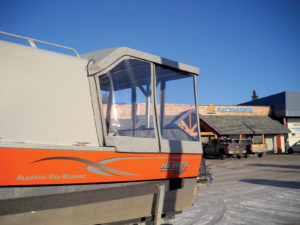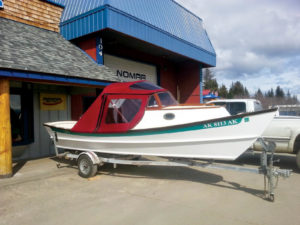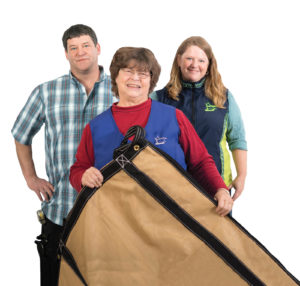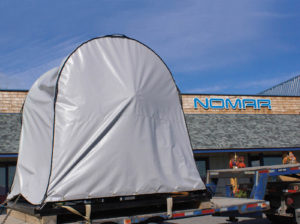Marine business passes to next generation

Homer Alaska-based NOMAR started in 1978 in a converted school bus with a barrel stove and one sewing machine. In 1995 the business moved into a 10,000-square-foot building with room for production facilities and a retail store.
In 2007, Kate Mitchell set up a 10-year plan to transition her business on the Alaskan frontier to her children. Today her children value the company’s courageous past and anticipate a bright future.
We didn’t homestead like the Kilcher family from Discovery Channel’s Alaska: The Last Frontier but we were here before the roads were paved,” says Kate Mitchell, founder and co-owner of NOMAR in Homer, Alaska. “This is a business we built from scratch on the new frontier, and now we’re in the fun, and sometimes challenging, process of transitioning management from me to my kids.”
Kate began her sewing career in Ketchikan, Alaska, in 1976 when her husband Ben was in the U.S. Coast Guard. When someone in Ben’s division wanted a boat top and asked Ben to take a shot at it, he said no. “My husband didn’t sew but my mother had taught me when I was a child. We needed the money for Christmas presents so I went to the marina to buy materials and figured out how to make a boat top,” Kate says. “The owners of the marina asked me to buy the boat top portion of their business and before I knew it we were moving the machine and materials to the kitchen table and that’s where the business started.”
Prosperity at the end of the road
In 1978 the U.S. Coast Guard transferred the family to Homer, and Kate opened the business as Mitchell’s Marine Canvas & Upholstery. At that time, Homer’s population was less than 2,000 people and Alaska had been a state for less than 20 years. “Alaska—all eight million square miles—only had a population of 300,000,” Kate says. “Though we were not really pioneers, our reasons for making Alaska home were based on personal freedoms and great fishing more than anything else.”
With a workshop housed in a converted GMC school bus on the outskirts of town, a barrel stove for heat and one commercial sewing machine, Kate began repairing boat tops—and whatever other fabric items people brought to her. “There were less than 100 boats in the harbor and very few recreational boats; most boats were commercial fishing boats,” Kate says. “There was this homestead mentality where you make do or do without so I sewed up a lot of really old beat-up stuff. But I kept hoping to someday make something new.”

The business has developed a diverse line of products including clothing, luggage and fisheries gear. Its full-service upholstery shop designs custom canvas boat enclosures, complete vessel rehabs, equipment covers, custom restaurant seating and more.
Opportunity knocks
The first real turning point for the business came in 1983 when three things happened—a fortuitous phone call, a fishing problem that needed a solution and a trip to the lower 48.
First, a call came from Industrial Fabrics Association International (IFAI). “By this time we had moved the business into a Quonset hut with a dirt floor. There was plywood on the portion of the floor where the sewing machine and table fit but we still heated with a coal stove and had an outhouse out back,” Kate says. “I don’t know how the heck IFAI found me but they did, and I joined. I started getting the magazine and reading stories of how other people ran and grew their businesses. All those articles were a huge help over the years.”
The next break came when two fishermen walked into the shop and said: “We have a problem we’re hoping you can help us with.” At that time salmon fishermen used seine web to lift salmon to deliver to the processors. Unfortunately the web that came in contact with the fish badly marked them, reducing their value. “They called the marked fish ‘Number Twos,’” Kate says. “They wanted me to make a smooth-sided bag. And we were able to design a product that has become THE way to transport salmon. If you deliver salmon, you deliver it in a NOMAR Brailer bag. NOMAR—which then became the name of the company—stands for No Marka the Fish.”
Soon after, Kate attended her first IFAI Expo, where she gathered more ideas, found suppliers and met other small business manufacturers—one of whom gave her advice that she’s glad she followed. Kate knew meeting the orders for Brailer bags was beyond her company’s capacity at that time and she was considering subcontracting the work out. “There was this one kind soul at the show who was there in work clothes, just like me,” she says. “He told me: ‘Don’t sub out your work. If you want the profits, you want to be in control. You’re just going to have to set up and manufacture it yourself.’
“We were lucky enough to have a nest egg from the sale of our home in Ketchikan so we could get that first run of material and a couple of sewing machines to meet the contract,” Kate continues. “It was a slow build from there.”

Richard Mitchell (Left), Kate Mitchell (Middle), and Jennifer Mitchell Hakala (Right).
Photo by Scott Dickerson.
Coming home
Richard and Jennifer both grew up working in the family business but each left Alaska after graduating from high school—Richard in ‘88 and Jennifer in ‘91. “The business was still so small and although they had worked side by side in the business, there were no jobs for them,” Kate says. “We didn’t have the money to send them to college either so they basically got one-way tickets to ‘America.’”
Jennifer worked at different jobs during her time in the lower 48, including working at a sew shop in Colorado, and Richard’s experience included doing interior finishings, and mechanical and electrical work on boats in Bellingham, Wash. “I also worked on the green chain at sawmills—anything to stay alive,” Richard says. “You take something from every job though—how to work for people and how to work with people.”
“Working at that sew shop planted a seed for me,” Jennifer says. “I realized maybe I was interested in working in the family business after all.”
Richard eventually returned to Homer to work in the family business, working in the company’s boatyard as he had before he left. “We had a full-on marina going on in the back of the business,” Richard says. “I went back to picking up blocks, moving boats, backing trailers and winterizing boats—as I had all of my youth.”
Two years later, Jennifer returned, sewing handles for Brailer bags. “I sewed Brailer handles until they were coming out of my ears,” she says. “I was the ‘handle girl.’”
In 1995 the boatyard was sold, and Kate and Ben purchased a building in town. The building had 10,000 square feet for production, space for a beautiful retail store—and room for growth and the transition to come from one generation to the other.

NOMAR’s custom equipment covers are made from Sea-Tarp fabric, a polyester that has been coated on both sides with virgin vinyl. It is designed for applications that require high tear and tensile strength, high adhesion and exceptional weather resistance. The fabric is an 18-ounce heavy-duty waterproof
vinyl that stays flexible to minus 20 degrees Fahrenheit.
Passing the torch
Richard and Jennifer worked their way up from those entry-level jobs, and now Richard is in charge of design and production, and Jennifer is the office manager. The leadership transition began in 2007. “They were both in good, stable situations,” Kate says. “By that time it was clear that they were ‘in.’ So we set up a 10-year plan for the transition.”
Kate, Richard and Jennifer consulted a lawyer and drafted a plan that included gifting 10 shares of stock each to Richard and Jennifer for all their years of hard work at little pay.
“From the profit they made off of that they started to buy more shares,” Kate says. “Now they each have 31 and could overrule me at any time. So I wouldn’t have to be here much anymore, but I still have fun at it so here I am.”
Richard and Jennifer’s plans for the company include continued slow growth and the hope that they can minimize the amount of diverse products the company has needed to include, and focus on fewer markets. “Diversity has worked for us but it’s also been a frustration,” Richard says. “With a stronger marketing plan, an awesome crew, a fresh website and 40 years of brick-and-mortar, our core is in place. We’re just looking for the next market. Quality products made in America.”
Sigrid Tornquist is a freelance writer and editor based in St. Paul, Minn.
 TEXTILES.ORG
TEXTILES.ORG 






